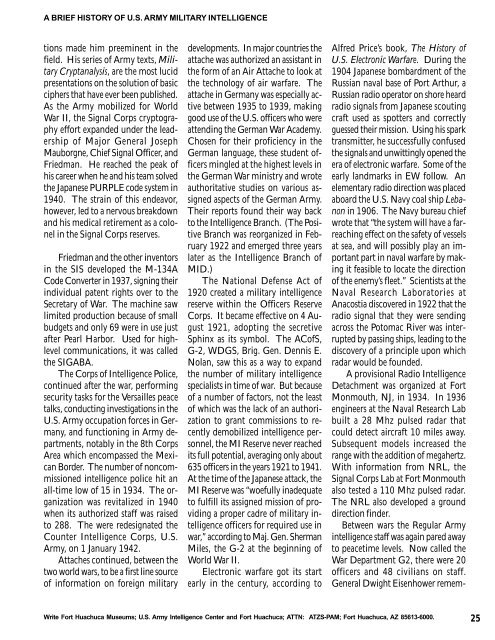Brief History of Army MI - Fort Huachuca - U.S. Army
Brief History of Army MI - Fort Huachuca - U.S. Army
Brief History of Army MI - Fort Huachuca - U.S. Army
Create successful ePaper yourself
Turn your PDF publications into a flip-book with our unique Google optimized e-Paper software.
A BRIEF HISTORY OF U.S. ARMY <strong>MI</strong>LITARY INTELLIGENCEtions made him preeminent in thefield. His series <strong>of</strong> <strong>Army</strong> texts, MilitaryCryptanalysis, are the most lucidpresentations on the solution <strong>of</strong> basicciphers that have ever been published.As the <strong>Army</strong> mobilized for WorldWar II, the Signal Corps cryptographyeffort expanded under the leadership<strong>of</strong> Major General JosephMauborgne, Chief Signal Officer, andFriedman. He reached the peak <strong>of</strong>his career when he and his team solvedthe Japanese PURPLE code system in1940. The strain <strong>of</strong> this endeavor,however, led to a nervous breakdownand his medical retirement as a colonelin the Signal Corps reserves.Friedman and the other inventorsin the SIS developed the M-134ACode Converter in 1937, signing theirindividual patent rights over to theSecretary <strong>of</strong> War. The machine sawlimited production because <strong>of</strong> smallbudgets and only 69 were in use justafter Pearl Harbor. Used for highlevelcommunications, it was calledthe SIGABA.The Corps <strong>of</strong> Intelligence Police,continued after the war, performingsecurity tasks for the Versailles peacetalks, conducting investigations in theU.S. <strong>Army</strong> occupation forces in Germany,and functioning in <strong>Army</strong> departments,notably in the 8th CorpsArea which encompassed the MexicanBorder. The number <strong>of</strong> noncommissionedintelligence police hit anall-time low <strong>of</strong> 15 in 1934. The organizationwas revitalized in 1940when its authorized staff was raisedto 288. The were redesignated theCounter Intelligence Corps, U.S.<strong>Army</strong>, on 1 January 1942.Attaches continued, between thetwo world wars, to be a first line source<strong>of</strong> information on foreign militarydevelopments. In major countries theattache was authorized an assistant inthe form <strong>of</strong> an Air Attache to look atthe technology <strong>of</strong> air warfare. Theattache in Germany was especially activebetween 1935 to 1939, makinggood use <strong>of</strong> the U.S. <strong>of</strong>ficers who wereattending the German War Academy.Chosen for their pr<strong>of</strong>iciency in theGerman language, these student <strong>of</strong>ficersmingled at the highest levels inthe German War ministry and wroteauthoritative studies on various assignedaspects <strong>of</strong> the German <strong>Army</strong>.Their reports found their way backto the Intelligence Branch. (The PositiveBranch was reorganized in February1922 and emerged three yearslater as the Intelligence Branch <strong>of</strong><strong>MI</strong>D.)The National Defense Act <strong>of</strong>1920 created a military intelligencereserve within the Officers ReserveCorps. It became effective on 4 August1921, adopting the secretiveSphinx as its symbol. The AC<strong>of</strong>S,G-2, WDGS, Brig. Gen. Dennis E.Nolan, saw this as a way to expandthe number <strong>of</strong> military intelligencespecialists in time <strong>of</strong> war. But because<strong>of</strong> a number <strong>of</strong> factors, not the least<strong>of</strong> which was the lack <strong>of</strong> an authorizationto grant commissions to recentlydemobilized intelligence personnel,the <strong>MI</strong> Reserve never reachedits full potential, averaging only about635 <strong>of</strong>ficers in the years 1921 to 1941.At the time <strong>of</strong> the Japanese attack, the<strong>MI</strong> Reserve was “woefully inadequateto fulfill its assigned mission <strong>of</strong> providinga proper cadre <strong>of</strong> military intelligence<strong>of</strong>ficers for required use inwar,” according to Maj. Gen. ShermanMiles, the G-2 at the beginning <strong>of</strong>World War II.Electronic warfare got its startearly in the century, according toAlfred Price’s book, The <strong>History</strong> <strong>of</strong>U.S. Electronic Warfare. During the1904 Japanese bombardment <strong>of</strong> theRussian naval base <strong>of</strong> Port Arthur, aRussian radio operator on shore heardradio signals from Japanese scoutingcraft used as spotters and correctlyguessed their mission. Using his sparktransmitter, he successfully confusedthe signals and unwittingly opened theera <strong>of</strong> electronic warfare. Some <strong>of</strong> theearly landmarks in EW follow. Anelementary radio direction was placedaboard the U.S. Navy coal ship Lebanonin 1906. The Navy bureau chiefwrote that “the system will have a farreachingeffect on the safety <strong>of</strong> vesselsat sea, and will possibly play an importantpart in naval warfare by makingit feasible to locate the direction<strong>of</strong> the enemy’s fleet.” Scientists at theNaval Research Laboratories atAnacostia discovered in 1922 that theradio signal that they were sendingacross the Potomac River was interruptedby passing ships, leading to thediscovery <strong>of</strong> a principle upon whichradar would be founded.A provisional Radio IntelligenceDetachment was organized at <strong>Fort</strong>Monmouth, NJ, in 1934. In 1936engineers at the Naval Research Labbuilt a 28 Mhz pulsed radar thatcould detect aircraft 10 miles away.Subsequent models increased therange with the addition <strong>of</strong> megahertz.With information from NRL, theSignal Corps Lab at <strong>Fort</strong> Monmouthalso tested a 110 Mhz pulsed radar.The NRL also developed a grounddirection finder.Between wars the Regular <strong>Army</strong>intelligence staff was again pared awayto peacetime levels. Now called theWar Department G2, there were 20<strong>of</strong>ficers and 48 civilians on staff.General Dwight Eisenhower remem-Write <strong>Fort</strong> <strong>Huachuca</strong> Museums; U.S. <strong>Army</strong> Intelligence Center and <strong>Fort</strong> <strong>Huachuca</strong>; ATTN: ATZS-PAM; <strong>Fort</strong> <strong>Huachuca</strong>, AZ 85613-6000.25
















